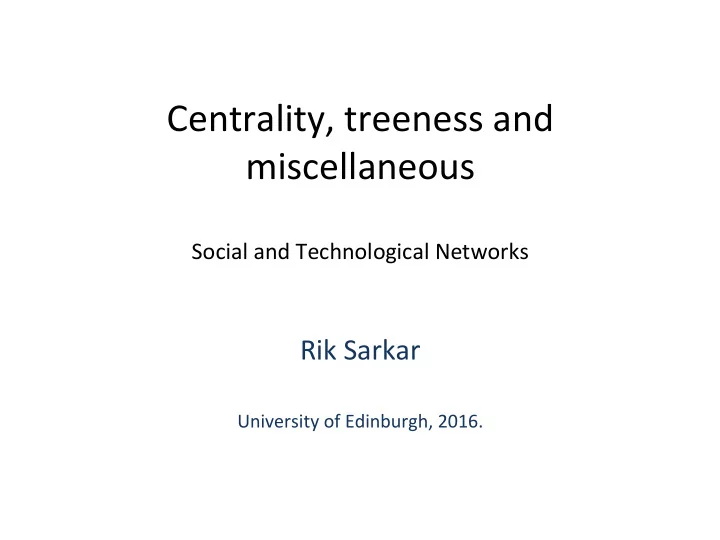

Centrality, treeness and miscellaneous Social and Technological Networks Rik Sarkar University of Edinburgh, 2016.
Centrality • How ‘central’ is a node in a network? – A noIon of importance of the node • E.g. degree, pagerank, beweenness..
• Degree centrality – Degree of a vertex • Closeness centrality ` x = 1 – Average distance to all other nodes X d ( x, y ) n • Decreases with centrality y • Inverse is an increasing measure of centrality C x = 1 n P d ( x, y ) = ` x
• Betweenness centrality – The number of shortest paths passing through a node • (see slides from strong and weak Ies) • Pagerank – See slides on web graphs and ranking pages – Pagerank is a type of Eigenvector centrality – Another eigen centrality is Katz centrality, which we will not discuss
k-core of a graph G • A maximal connected subgraph where each vertex has a degree at least k – Inside that subgraph. • Obtained by repeatedly deleIng verIces of degree less than k
Internet • An interconnecIon network of “network of routers” • Thousands of networks together form the Internet • The “center” consists of big routers in highly connected networks, many connecIons between adjacent networks • Outer layers have smaller routers and sparser connecIons
Internet • Has a layered structure with higher connecIvity at the core – A routed packet tends to use high connecIvity regions to get shorter/faster routes – EffecIvely a tree-like structure • Known to have power law distribuIon of degrees
A test for tree metrics • A metric is a tree metric if and only if it saIsfies this 4 Point CondiIon: • Any 4 nodes (points in the metric space) can be ordered as w,x,y,z such that: • d(w,x) + d(y,z) ≤ d(w,y) + d(x,z) ≤ d(w,z) + d(x,y) and • d(w,y) + d(x,z) = d(w,z) + d(x,y)
Trees tend to have high loads in “center” • Since many routes will have to go through the center
Almost tree metrics • Real networks are not exactly trees • Let’s measure how far a network is from a tree • 4PC- 𝜁 for a set of 4 nodes is the smallest 𝜁 that saIsfies: • d(w,x) + d(y,z) ≤ d(w,y) + d(x,z) ≤ d(w,z) + d(x,y) and • d(w,z) + d(x,y) ≤ d(w,y) + d(x,z) + 2 𝜁 ᐧ min{d(w,x),d(y,z)} ᐧ min{d(w,x),d(y,z)}
Almost tree metrics • A tree has 𝜁 = 0 • A metric space with smaller 𝜁 implies that it is more similar to a tree – Theorem: A metric space with small 𝜁 can be embedded into a tree with correspondingly small distorIon – Ref: I Abraham et al. ReconstrucIng approximate tree metrics, PODC 07.
Treeness of Internet • PlanetLab: A distributed collecIon of servers around the world • Experiment based on latency (communicaIon delay) as an esImate of distance • Shows the distance metric between servers is similar to a tree, and far from a sphere • Ref: I Abraham et al. ReconstrucIng approximate tree metrics, PODC 07. • V. Ramasubramanian etal. On treeness of internet latency and bandwidth, Sigmetrics 09.
Treeness of metrics • δ-hyperbolic metrics • d(w,x) + d(y,z) ≤ d(w,y) + d(x,z) ≤ d(w,z) + d(x,y) and • d(w,z) + d(x,y) = d(w,y) + d(x,z) + δ • Uses an absolute value δ • Instead of a mulIplicaIve factor
δ-hyperbolic metrics: Thin triangles • AlternaIve definiIon • Any point on a triangle must be within distance δ of one of the other sides • The middle of the triangles are squeezed together • trees have δ = 0: most hyperbolic
Curvatures of spaces • Spherical : +ve curvature • Triangle centers are “Fat” • Flat (Euclidean): 0 Curvature • Hyperbolic: -ve curvature
• Any hyperbolic space is δ-hyperbolic for some finite delta • Not the case for Euclidean and spherical spaces • For more on δ-hyperbolic spaces, See: Gromov hypoerbolic spaces
• Any tree can be embedded in a hyperbolic space with a low distorIon • R. Sarkar. “Low distorIon delaunay embedding of trees in hyperbolic plane.” GD 2011.
• Internet has good embedding in hyperbolic spaces • Ref. Shavik and Tankel 2008, Narayan and Saniee 2011
• Model for power law social networks with clustering properIes • Place nodes in hyperbolic plane – Later nodes are farther away from center – At random angle from center – Nodes connect probabilisIcally to nodes closer in hyperbolic distance • Ref: Popularity vs similarity in growing networks – Papdopoulos et al. Nature 2012
Course • Project: – Submission tomorrow – Individual submissions and report – Read submission instruc4ons carefully – Submit early. Do not keep for the last moment. You can always resubmit • Lecture: – Last lecture Friday – Discussion of course, study material, exams • Exam material: – Slides. – Items in “Reading”. – Not “AddiIonal” reading, or references in slides.
Recommend
More recommend